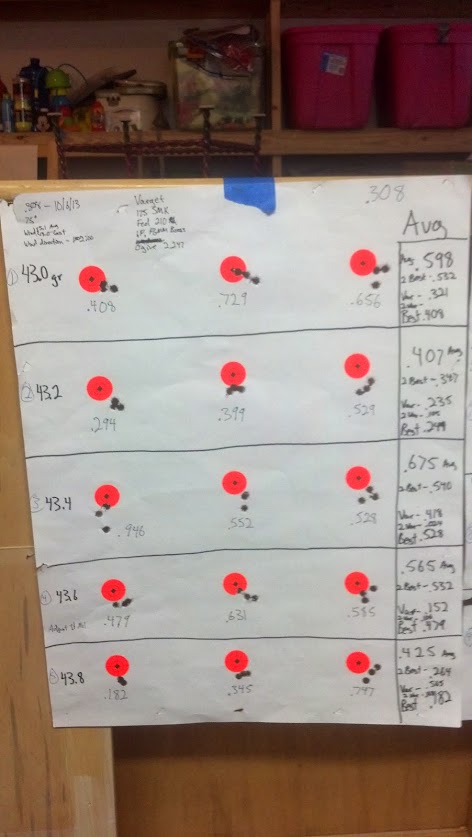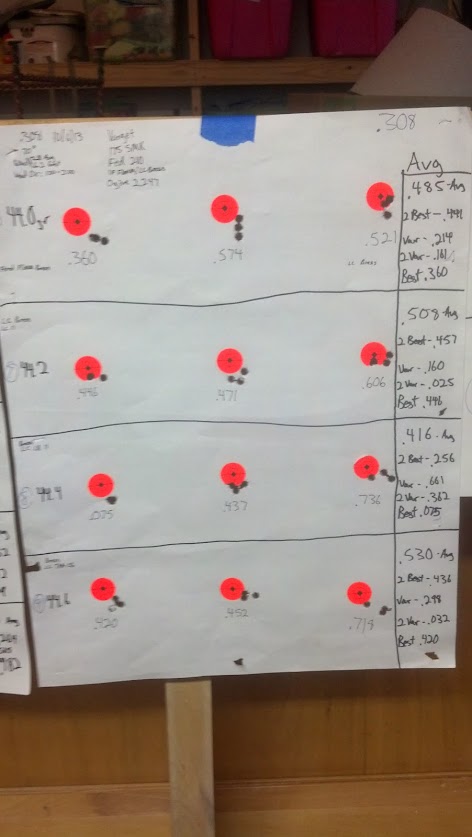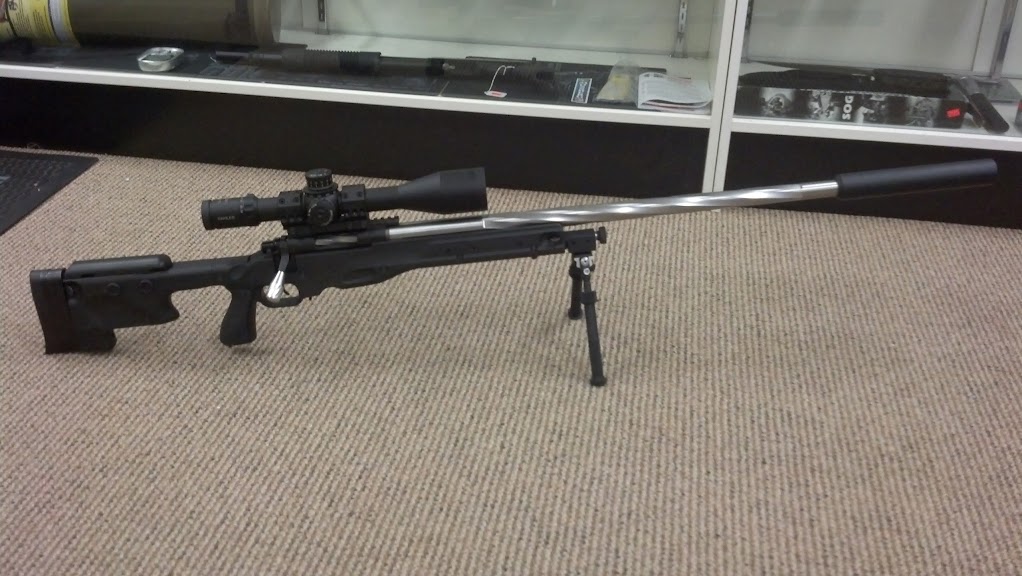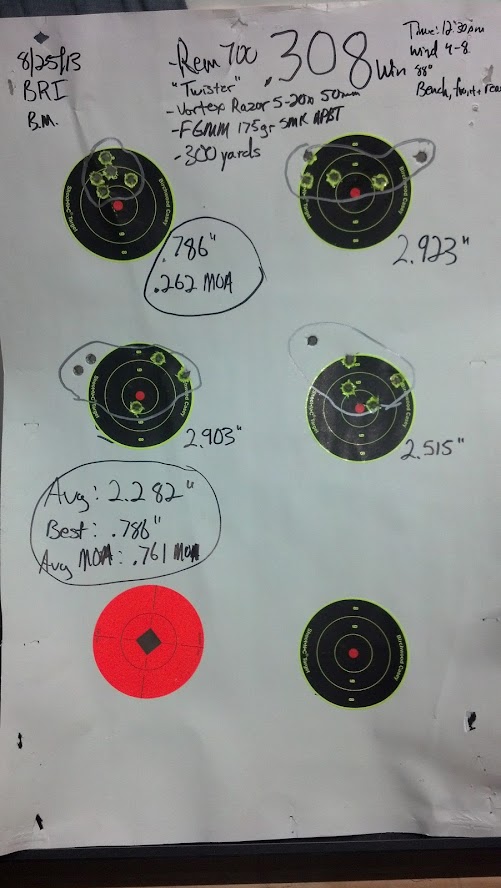Thank you in advance to anyone that reads through all of my post and provides insight and advice. I do appreciate it and place a high value on the knowledge I gain from this website.
I am new to reloading and relatively new to long range shooting, and this is the first load development I have done for a rifle. I started by trying various factory loads at various weights, and my .308 definitely liked the FGMM 175gr the most so I'm using those bullets and Varget powder. The Hodgdon loading manual shows a Min - Max charge for Varget of 42.0 - 45.0. Based on a number of things I've read, I left out the lower portion of the range and loaded enough to shoot 3, 3 shot groups at each charge from 43.0 to 45.0 in .2 increments. I realize 99 rounds may be overkill, but the more practice I get behind the rifle and at the loading bench the better I will get. I started at 43.0, shot all 3 groups, and proceeded through each charge weight the same way. There was no round robin. All shooting was done from a bench off of an Atlas bipod with rear bags. Below are my targets and results.
I am looking for help analyzing the targets, identifying nodes, and advice on the next step. I didn't exactly follow the OCW Test or Ladder test, but I will likely go back and do both of them just to compare what I find doing it this way. The 3 pictures are of all of the charges going top to bottom, and I found the "best" charge weights based on a combination of the lowest average group size of the best two groups (excluding the worst group to allow for shooter error) and most consistent POI. I will list the measurements for each charge weight above the corresponding picture. It should be noted, although relatively "new" to long range shooting, I am capable of consistently shooting 5 shot group 1 MOA and under with my 5.56 gas gun and .5 MOA 5 shot groups with a bolt gun.
I took the following measurements at each charge weight which is shown in the same order on the right side of the target:
- Average of 3 groups: Labeled "Avg"
- Average of 2 smallest groups: Labeled "2 best Avg"
- Variance or spread between largest and smallest group: Labeled "Var"
- Variance or spread between 2 smallest groups: Labeled "2 Var"
- Smallest group size: Labeled "Best"
Charge Weights 43.0 - 43.8
43.0 grains
- Avg .598
- 2 Avg .532
- Var .321
- 2 Var .248
- Best .408
43.2 grains
- Avg .407
- 2 Avg .347
- Var .235
- 2 Var.105
- Best .294
43.4 grains
- Avg .675
- 2 Avg .540
- Var .418
- 2 Var .024
- Best .528
43.6 grains
- Avg .565
- 2 Avg .532
- Var .152
- 2 Var .106
- Best .479
43.8 grains
- Avg .425
- 2 Avg .264
- Var .565
- 2 Var .163
- Best .182

Charge Weights 44.0 gr to 44.6 gr
44.0 grains
- Avg .485
- 2 Avg .441
- Var .214
- 2 Var .161
- Best .360
44.2 grains
- Avg .508
- 2 Avg .457
- Var .160
- 2 Var .025
- Best .446
44.4 grains
- Avg .416
- 2 Avg .256
- Var .661
- 2 Var .362
- Best .075 ***LOWEST***
44.6 grains
- Avg .530
- 2 Avg .436
- Var .298
- 2 Var .032
- Best .420

Charge Weights 44.8 gr to 45.0 gr
44.8 grains
- Avg .498
- 2 Avg .402
- Var .320
- 2 Var .066
- Best .369
45.0 grains
- Avg .374
- 2 Avg .229***LOWEST***
- Var .499
- 2 Var .127
- Best .165

I put the nodes in bold. They were at 43.2, 43.8, 44.4, and 45.0. All .6 gr apart. The "best" charge weight appears to be 45.0 gr. While it doesn't have the smallest group, it does have the smallest average of the best 2 groups in its charge weight, with both of those groups looking like they have nearly an identical POI. The only problem is I was getting sticky bolt at 45.0 gr. To me, the next logical step would be to load up 15 - 20 rounds at each of those charge weights and then shoot either 2 different 10 shot groups or 4 different 5 shot groups at each one to see which is most consistent. But that sure is a lot of shooting to narrow down the OCW.
Additional information
Rifle Info:
- .308 Win
- Rem 700 action trued
- Krieger 26" barrel with 1:12 twist
- Krieger #17 contour
- Huber 2 stage trigger with 2.5 lb break at 2nd stage
- AICS 1.5 chassis
- Vortex Razor 5 - 20 with Seekins rings
- Atlas bipod
Load info:
- 175 gr SMK
- Varget
- FGMM brass and various Lake City brass (all charge weights were shot with the same headstamp)
- Fed 210
I am new to reloading and relatively new to long range shooting, and this is the first load development I have done for a rifle. I started by trying various factory loads at various weights, and my .308 definitely liked the FGMM 175gr the most so I'm using those bullets and Varget powder. The Hodgdon loading manual shows a Min - Max charge for Varget of 42.0 - 45.0. Based on a number of things I've read, I left out the lower portion of the range and loaded enough to shoot 3, 3 shot groups at each charge from 43.0 to 45.0 in .2 increments. I realize 99 rounds may be overkill, but the more practice I get behind the rifle and at the loading bench the better I will get. I started at 43.0, shot all 3 groups, and proceeded through each charge weight the same way. There was no round robin. All shooting was done from a bench off of an Atlas bipod with rear bags. Below are my targets and results.
I am looking for help analyzing the targets, identifying nodes, and advice on the next step. I didn't exactly follow the OCW Test or Ladder test, but I will likely go back and do both of them just to compare what I find doing it this way. The 3 pictures are of all of the charges going top to bottom, and I found the "best" charge weights based on a combination of the lowest average group size of the best two groups (excluding the worst group to allow for shooter error) and most consistent POI. I will list the measurements for each charge weight above the corresponding picture. It should be noted, although relatively "new" to long range shooting, I am capable of consistently shooting 5 shot group 1 MOA and under with my 5.56 gas gun and .5 MOA 5 shot groups with a bolt gun.
I took the following measurements at each charge weight which is shown in the same order on the right side of the target:
- Average of 3 groups: Labeled "Avg"
- Average of 2 smallest groups: Labeled "2 best Avg"
- Variance or spread between largest and smallest group: Labeled "Var"
- Variance or spread between 2 smallest groups: Labeled "2 Var"
- Smallest group size: Labeled "Best"
Charge Weights 43.0 - 43.8
43.0 grains
- Avg .598
- 2 Avg .532
- Var .321
- 2 Var .248
- Best .408
43.2 grains
- Avg .407
- 2 Avg .347
- Var .235
- 2 Var.105
- Best .294
43.4 grains
- Avg .675
- 2 Avg .540
- Var .418
- 2 Var .024
- Best .528
43.6 grains
- Avg .565
- 2 Avg .532
- Var .152
- 2 Var .106
- Best .479
43.8 grains
- Avg .425
- 2 Avg .264
- Var .565
- 2 Var .163
- Best .182

Charge Weights 44.0 gr to 44.6 gr
44.0 grains
- Avg .485
- 2 Avg .441
- Var .214
- 2 Var .161
- Best .360
44.2 grains
- Avg .508
- 2 Avg .457
- Var .160
- 2 Var .025
- Best .446
44.4 grains
- Avg .416
- 2 Avg .256
- Var .661
- 2 Var .362
- Best .075 ***LOWEST***
44.6 grains
- Avg .530
- 2 Avg .436
- Var .298
- 2 Var .032
- Best .420

Charge Weights 44.8 gr to 45.0 gr
44.8 grains
- Avg .498
- 2 Avg .402
- Var .320
- 2 Var .066
- Best .369
45.0 grains
- Avg .374
- 2 Avg .229***LOWEST***
- Var .499
- 2 Var .127
- Best .165

I put the nodes in bold. They were at 43.2, 43.8, 44.4, and 45.0. All .6 gr apart. The "best" charge weight appears to be 45.0 gr. While it doesn't have the smallest group, it does have the smallest average of the best 2 groups in its charge weight, with both of those groups looking like they have nearly an identical POI. The only problem is I was getting sticky bolt at 45.0 gr. To me, the next logical step would be to load up 15 - 20 rounds at each of those charge weights and then shoot either 2 different 10 shot groups or 4 different 5 shot groups at each one to see which is most consistent. But that sure is a lot of shooting to narrow down the OCW.
Additional information
Rifle Info:
- .308 Win
- Rem 700 action trued
- Krieger 26" barrel with 1:12 twist
- Krieger #17 contour
- Huber 2 stage trigger with 2.5 lb break at 2nd stage
- AICS 1.5 chassis
- Vortex Razor 5 - 20 with Seekins rings
- Atlas bipod
Load info:
- 175 gr SMK
- Varget
- FGMM brass and various Lake City brass (all charge weights were shot with the same headstamp)
- Fed 210


